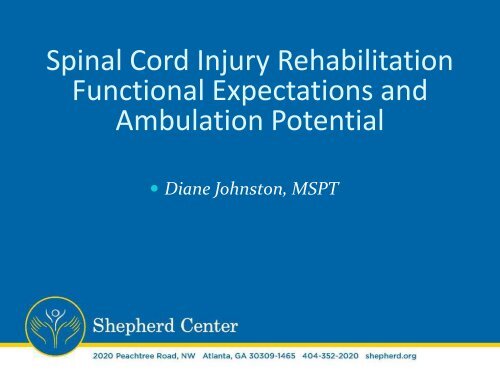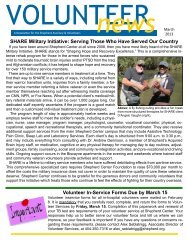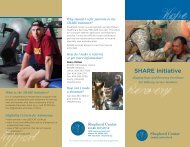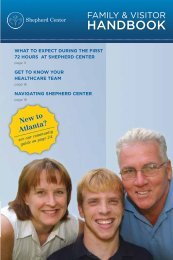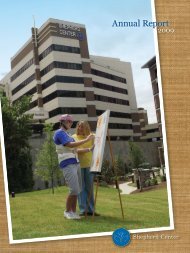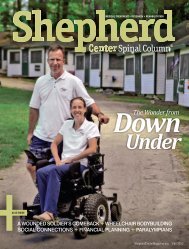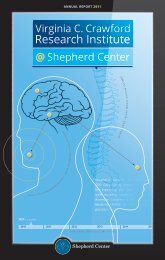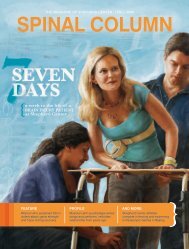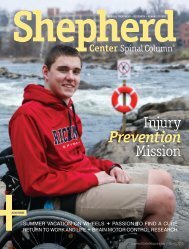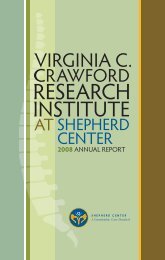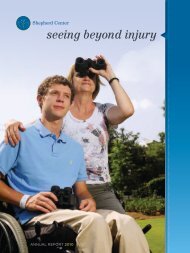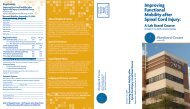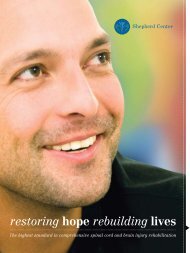Spinal Cord Injury Rehabilitation Functional ... - Shepherd Center
Spinal Cord Injury Rehabilitation Functional ... - Shepherd Center
Spinal Cord Injury Rehabilitation Functional ... - Shepherd Center
You also want an ePaper? Increase the reach of your titles
YUMPU automatically turns print PDFs into web optimized ePapers that Google loves.
<strong>Spinal</strong> <strong>Cord</strong> <strong>Injury</strong> <strong>Rehabilitation</strong><br />
<strong>Functional</strong> Expectations and<br />
Ambulation Potential<br />
• Diane Johnston, MSPT
Objectives for the course<br />
• Participants will have a general understanding of the<br />
epidemiology of <strong>Spinal</strong> <strong>Cord</strong> <strong>Injury</strong> (SCI).<br />
• Participants will better understand the levels of <strong>Spinal</strong><br />
<strong>Cord</strong> <strong>Injury</strong> and their functional implications<br />
• Participants will have an awareness of the American<br />
<strong>Spinal</strong> <strong>Injury</strong> Association (ASIA) Impairment Scale<br />
• Participants will have a better understanding of incomplete<br />
SCI clinical syndromes and their relationship to<br />
ambulation potential.
Demographics - SCI<br />
• Incidence: 12,000 cases<br />
per year<br />
• Prevalence: 231,000 to<br />
311,000<br />
• Mean age 40.2 since 2005<br />
(28.7 years 1973-1979)<br />
• Gender: 80.8% male,<br />
19.2% female<br />
• Race: 66.2% Caucasian,<br />
27.0% African American ,<br />
7.9% Hispanic, 2% Asian<br />
Source: National <strong>Spinal</strong> <strong>Cord</strong> <strong>Injury</strong> Statistical <strong>Center</strong>, February 2010
Etiology<br />
Source: National <strong>Spinal</strong> <strong>Cord</strong> <strong>Injury</strong> Statistical <strong>Center</strong>, February 2010
Neurological Level<br />
• Tetraplegia 55.1%<br />
• Complete 16.9%<br />
• Incomplete 38.3%<br />
• Paraplegia 44.4%<br />
• Complete 22.9%<br />
• Incomplete 21.5%<br />
• Less than 1% experience full<br />
recovery<br />
Source: National <strong>Spinal</strong> <strong>Cord</strong> <strong>Injury</strong> Statistical <strong>Center</strong>, February 2010
Neurological Level By Age<br />
PC<br />
PI<br />
TC<br />
TI<br />
16-30 46-60 61-75 76+
Average Yearly Expenses<br />
2009 dollars<br />
Severity First Year Each<br />
Subsequent Yr<br />
C1-4 $829,843 $148,645<br />
C5-8 $535,877 $ 60,887<br />
Para $303,220 $ 30,855<br />
Motor<br />
Incomplete<br />
$244,562 $ 17,139<br />
Source: National <strong>Spinal</strong> <strong>Cord</strong> <strong>Injury</strong> Statistical <strong>Center</strong>, February 2010
Life Expectancy<br />
Age at injury Para C5-C8 C1-4 Vent<br />
Dependent<br />
20 years 45.8 41.0 37.4 23.8<br />
40 years 28.2 24.2 21.2 11.4<br />
60 years 13.2 10.4 8.6 3.2<br />
Source: National <strong>Spinal</strong> <strong>Cord</strong> <strong>Injury</strong> Statistical <strong>Center</strong>, February 2010
Estimated Lifetime Costs<br />
Severity<br />
C1-4 $3,273,270<br />
Assuming 25 years old<br />
at time of injury<br />
C5-8 $1,850,805<br />
Para $1,093,669<br />
Motor Incomplete $729,560<br />
Source: National <strong>Spinal</strong> <strong>Cord</strong> <strong>Injury</strong> Statistical <strong>Center</strong>, February 2010
Number of SCI Patients Served<br />
• Overall 1,761 SCI persons<br />
served per year<br />
• Inpatient: 402 patients<br />
• Outpatient:<br />
• Day Program: 319<br />
• Single Service: 473<br />
• Beyond Therapy: 30<br />
• Promotion Wellness: 537<br />
• UE Clinic: 297<br />
• Numbers lead to<br />
expertise!<br />
<strong>Shepherd</strong> Data: 04/01/2009-03/31/2010
Then and Now<br />
• LOS<br />
• Acute care<br />
• 1974: 25 days<br />
• 2010: 15 days<br />
• Rehab<br />
• 1974: 115 days<br />
• 2010: 36 days<br />
• Average age at injury<br />
• 1973-1989: 28.7 years<br />
• 2005-present: 40.2 years<br />
• Injuries at 60 yo+<br />
• 1979: 4.7%<br />
• 2010: 26.8%<br />
• Severity of injury<br />
• ↓in complete injuries (41%)<br />
• ↑in incomplete injuries (53%)<br />
• Plasticity of the spinal cord!!!
<strong>Functional</strong> Expectations
Definition:<br />
Complete vs/Incomplete <strong>Injury</strong><br />
• Complete <strong>Injury</strong>: An absence of sensory and motor function in<br />
the lowest sacral segment.*<br />
• Incomplete <strong>Injury</strong>: Partial preservation of sensory and/or motor<br />
function is found below the neurological level and includes the<br />
lowest sacral segment.<br />
• Zone of Partial Preservation: Used only with complete injuries<br />
and refers to those dermatomes and myotomes caudal to the<br />
neurological level that remain partially innervated.<br />
• *Water, R.L., Adkins, R.H., Yakura, J.S.: Definition of Complete spinal cord<br />
injury. Paraplegia 1991; 9:573-581.
Neurological Categories<br />
at Discharge<br />
• Incomplete tetraplegia 30.61%<br />
• Complete paraplegia 25.3%<br />
• Complete tetraplegia 20.0%<br />
• Incomplete paraplegia 18.6%<br />
• No deficits 0.6%<br />
• Unknown 3.4%<br />
National <strong>Spinal</strong> <strong>Cord</strong> <strong>Injury</strong> Statistical <strong>Center</strong> 2009-2010
C1-3<br />
• Respiratory: Vent<br />
• Bowel: 1<br />
• Bladder : 1<br />
• Bed Mobility : 1<br />
• Transfers: 1<br />
• Pressure Relief: 6<br />
• Eating: 1<br />
• Grooming: 1<br />
• Bathing: 1<br />
• Wheelchair Prop: 6<br />
• Communication: 5<br />
• Transportation: 1<br />
• Home making: 1
C1-3 Assistance Required<br />
• 24-hour attendant care<br />
to include<br />
homemaking<br />
• Able to instruct all<br />
aspects of care
C4<br />
• Respiratory: No vent<br />
• Bowel: 1<br />
• Bladder : 1<br />
• Bed Mobility : 1<br />
• Transfers: 1<br />
• Pressure Relief: 6<br />
• Eating: 1<br />
• Grooming: 1<br />
• Bathing: 1<br />
• Wheelchair Prop: 6<br />
• Communication: 5<br />
• Transportation: 1<br />
• Home making: 1
C4 Assistance Required<br />
• 24-hour care to include<br />
homemaking<br />
• Able to instruct all<br />
aspects of care
C5<br />
• Bowel: 1<br />
• Bladder: 1<br />
• Bed Mobility: 2-3<br />
• Transfers 1-2<br />
• Pressure Relief: 6<br />
• Eating: 5<br />
• Dressing:<br />
• Upper body: 4<br />
• Lower body: 1-2<br />
• Grooming: 1-3<br />
• Bathing: 1-3<br />
• Wheelchair prop: 6<br />
• Communication: 5<br />
• Transportation: 6<br />
• Home making 1
C5 Assist Required<br />
• Person care: 10 hours<br />
per day<br />
• Home care: 6 hours per<br />
day
C6<br />
• Bowel: 3-5<br />
• Bladder: 3:6<br />
• Bed mobility: 3-6<br />
• Transfers: 3-6<br />
• Pressure Relief: 6<br />
• Eating: 6<br />
• Dressing<br />
• UE 6<br />
• LE 3-6<br />
• Grooming: 5-6<br />
• Bathing: 4-6<br />
• Wheelchair: 6<br />
• Communication: 6-7<br />
• Transportation: 6<br />
• Home making:<br />
• Light meals:5-6
C6<br />
• Personal Care: 6 hours<br />
per day<br />
• Homecare: 4 hours per<br />
day
C7-8<br />
• Bowel: 6<br />
• Bladder: 6<br />
• Bed mobility: 6-7<br />
• Transfers: 6<br />
• Pressure relief: 6<br />
• Eating: 7<br />
• Dressing: 6-7<br />
• Grooming: 6-7<br />
• Bathing: 6-7<br />
• Wheelchair prop:<br />
• Manual: 6<br />
• Power: 6<br />
• Communication: 6<br />
• Transportation: 6<br />
• Homemaking:<br />
• Meal prep: 6<br />
• Heavy housecleaning: 4-6
Assist Required C7-8<br />
• Personal Care: 2-4<br />
hours per day<br />
• Homecare: 2 hours per<br />
day
Para (T1-9) Para (T10 and ↓)<br />
• Bowel: 6<br />
• Bladder: 6<br />
• Bed Mobility: 6<br />
• Pressure Relief: 6<br />
• Transfers: 6-7<br />
• Eating:7<br />
• Dressing: 7<br />
• Grooming: 7<br />
• Wheelchair: 6<br />
• Communication: 7<br />
• Home making: 6-7<br />
• All the same<br />
• Add:<br />
• Ambulation<br />
• Bracing<br />
• Assistive Devices<br />
• Different levels of<br />
community ambulation<br />
• Below L2 generally<br />
independent at community<br />
level
Para Assist Required<br />
• Personal care: 0 hours<br />
per day<br />
• Homemaking 0-2<br />
hours per day
Statistically the percentage of<br />
incomplete spinal cord injured (SCI)<br />
persons has continued to increase as<br />
emergency medical care has improved.
The variability seen<br />
in neurological<br />
recovery challenges<br />
the clinician in<br />
planning for these<br />
clients functional<br />
needs.
5 Most Common Levels of <strong>Injury</strong><br />
• C5: 14.9%<br />
• C4: 13.6%<br />
• C6: 10.8%<br />
• T12: 6.7%<br />
• C7: 5.3%<br />
Source: National <strong>Spinal</strong> <strong>Cord</strong> <strong>Injury</strong> Statistical <strong>Center</strong>
MRI<br />
• Hemorrhage with median<br />
length of 10.5 mm<br />
associated with complete<br />
spinal cord injury<br />
• Hemorrhage of less than 4<br />
mm associated with<br />
incomplete spinal cord<br />
injuries with good<br />
prognosis<br />
http://bjr.birjournals.org/cgi/content/full<br />
/76/905/347<br />
Source: Boldin C, et al. Spine. 2006;31(5):554-559.
ASIA Impairment Scale (AIS)<br />
AIS Changes Admission No Change Improved Declined<br />
A 48.0% 86.7% 11.3% 0%<br />
B 13.1% 46.9% 45.6% 4.5%<br />
C 14.7% 41.9% 52.7% 3.0%<br />
D 18.0% 90.1% 4.8% 2.1%<br />
A= Complete <strong>Injury</strong><br />
B= Incomplete, sensory only<br />
C= Incomplete, motor (non functional)<br />
D= Incomplete, motor (functional)<br />
Source: National <strong>Spinal</strong> <strong>Cord</strong> <strong>Injury</strong> Statistical <strong>Center</strong>, January 2008
ASIA and Walking Outcomes<br />
• Attained independent walking by inpatient DC<br />
• AIS A: 6.4%<br />
• AIS B: 23.5%<br />
• AIS C: 51.4%<br />
• AIS D: 88.6%<br />
Morganti et al, 2005
Clinical Syndromes<br />
• Central cord Syndrome<br />
• Anterior <strong>Spinal</strong> Artery Syndrome<br />
• Brown-Sequard Syndrome<br />
• Posterior <strong>Cord</strong> Syndrome<br />
• Cauda Equina Syndrome<br />
• Conus Medullaris Syndrome<br />
• Other diagnoses: Multiple sclerosis,<br />
transverse myelitis, spinal cord tumors,<br />
Gillian Barre’ Syndrome, peripheral<br />
neuropathies, and amyotrophic lateral<br />
sclerosis
Central <strong>Cord</strong> Syndrome<br />
• Hyperextension injury<br />
• Impairment of function<br />
greater in upper<br />
extremities than lower<br />
extremities<br />
• Majority of incomplete<br />
lesions result in this<br />
syndrome.<br />
• 77% of these clients will<br />
ambulate.<br />
Bosch A et al, 1971
Anterior <strong>Spinal</strong> Artery Syndrome<br />
• Flexion injury<br />
• Loss of motor<br />
functions, pain and<br />
temperature sensation<br />
• Prognosis poor for<br />
ambulation.<br />
Bosch A et al, 1971
Brown-Sequard Syndrome<br />
• Caused by penetrating injures<br />
(gun shot or stabs wounds)<br />
• Hemi section of the spinal cord<br />
• Loss of movement and position<br />
sense on the same side<br />
• Loss of pain and light touch on<br />
opposite side<br />
• Nearly all regain some level of<br />
ambulation<br />
• Prognosis for recovery is good<br />
• 80% regain hand function<br />
• 80 – 100% gain bowel and<br />
bladder function<br />
Bosch A et al, 1971
Posterior <strong>Cord</strong> Syndrome<br />
• Very rare<br />
• Caused by compression from a<br />
tumor or infarction<br />
• Motor function is preserved<br />
• Sensory modalities are lost<br />
below the level of injury<br />
• <strong>Functional</strong> ambulation is<br />
difficult despite having strong<br />
muscles<br />
Bosch A et al, 1971
Cauda Equina Syndrome<br />
• <strong>Injury</strong> to the L1 vertebral<br />
level and below<br />
• Lower motor neuron<br />
lesion<br />
• In most cases it is a<br />
complete lesion<br />
• Ambulation is probable<br />
due to the injury being<br />
low (quadriceps muscles<br />
are spared)
Conus Medullaris<br />
• <strong>Injury</strong> to the sacral cord<br />
and lumbar nerve root<br />
within the neural canal<br />
• Lower extremity motor<br />
and sensory loss<br />
• Areflexic bladder and<br />
bowel<br />
• Can usually ambulate
Motor Indicators<br />
• Lower extremity motor scores (Waters et al, 1994):<br />
• 20 or less use a wheelchair as their primary mode<br />
of locomotion<br />
• 30 or more can become community ambulators<br />
• Walked at community level by 1 year if (Gittler et al,<br />
2002):<br />
• Tetra plegia with LEMS of 20+<br />
• Paraplegia with LEMS of 10+<br />
• Initial muscle grade of 1/5 (trace) recovered to<br />
muscle grade of 3/5 (fair) within 3 months of the<br />
initial injury (Ditunno et al, 1992)
Sensory Indicators<br />
• Baseline lower extremity pin prick<br />
preservation and sacral pinprick<br />
preservation at 4 weeks post injury are<br />
associated with an improved prognosis<br />
for ambulation (Oleson et al, 2005)<br />
• Muscles that initially scored 0/5 (Poynton<br />
et al, 1997)<br />
• Dermatomes with spared pin prick, 85%<br />
regained ≥3/5 strength<br />
• Dermatomes without spared pin prick, 1.3%<br />
regained ≥3/5 strength
Age<br />
• Regaining walking function:<br />
• If younger than 50 2x more likely<br />
to walk at discharge (Burns et al,<br />
1997)<br />
• Younger subjects more likely to<br />
regain walking (Scivoletto et al,<br />
2003)
Active Weight Bearing<br />
Tilt Table/Standing Frame<br />
• Combine with E-stim/vibration<br />
• Angle footplates for tight ankles.<br />
Incorporate US/STM<br />
• Adjustable knees, seat and chest<br />
positions for therapeutic exercise
Pool<br />
• Shallow (aerobic steps, sitting,<br />
standing therapeutic exercise,<br />
walking all directions with device or<br />
buoy bars)<br />
• Deep water (inner tubes, foam<br />
noodles, etc)<br />
• Lap swim (supine with inflatable<br />
neck support, ski belt, ankle floats,<br />
½ flippers to increase<br />
proprioceptive awareness and<br />
resistance)
Initiating Gait with Body-Weight<br />
Support Treadmill Systems<br />
• Robotic<br />
• Lokomat® (Hocoma)<br />
• Autoambulator (Health South)<br />
• Manual<br />
• TheraStride, Biodex, etc<br />
• Lite Gait® (with or without treadmill)
Video With Trainer AFO
Video Scott Craig Orthoses
Para Step Video
Fillauer Stance Control Knee Joint<br />
www.fillauer.com
Patient Video: Stance Control Brace
Patient Video: Stance Control Brace<br />
on Stairs
Video with Malleolocs<br />
Treadmill with Beach Ball<br />
Balance Board w/ Hoola Hoop
So Much Available to Us<br />
Think Outside The Box
Questions?


